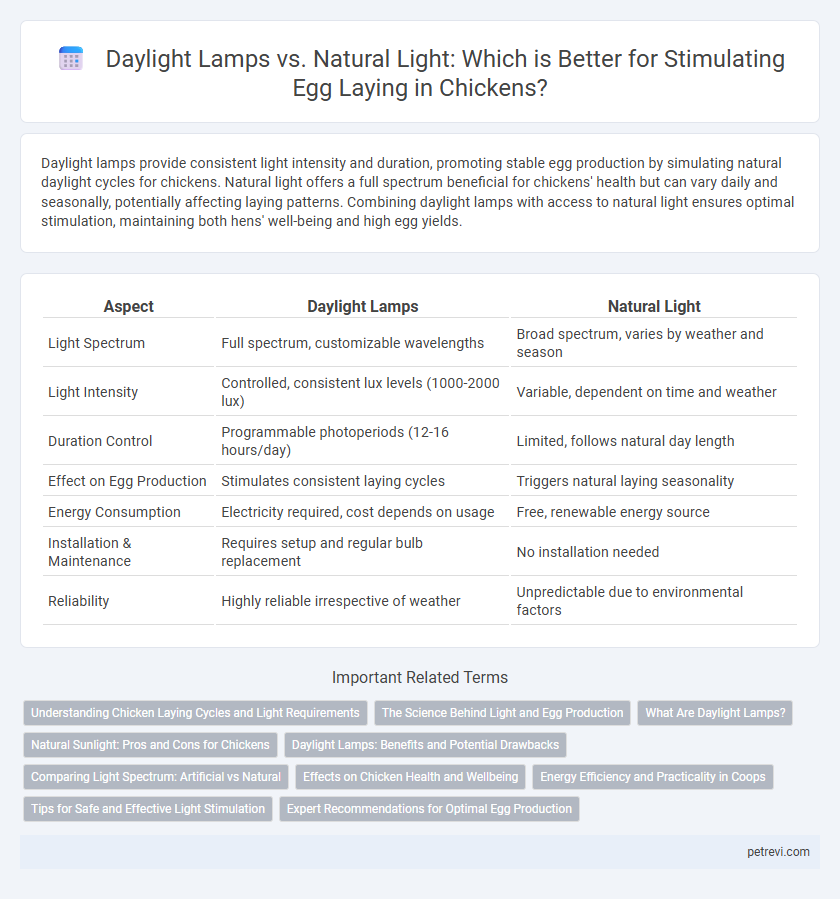Daylight lamps provide consistent light intensity and duration, promoting stable egg production by simulating natural daylight cycles for chickens. Natural light offers a full spectrum beneficial for chickens' health but can vary daily and seasonally, potentially affecting laying patterns. Combining daylight lamps with access to natural light ensures optimal stimulation, maintaining both hens' well-being and high egg yields.
Table of Comparison
| Aspect | Daylight Lamps | Natural Light |
|---|---|---|
| Light Spectrum | Full spectrum, customizable wavelengths | Broad spectrum, varies by weather and season |
| Light Intensity | Controlled, consistent lux levels (1000-2000 lux) | Variable, dependent on time and weather |
| Duration Control | Programmable photoperiods (12-16 hours/day) | Limited, follows natural day length |
| Effect on Egg Production | Stimulates consistent laying cycles | Triggers natural laying seasonality |
| Energy Consumption | Electricity required, cost depends on usage | Free, renewable energy source |
| Installation & Maintenance | Requires setup and regular bulb replacement | No installation needed |
| Reliability | Highly reliable irrespective of weather | Unpredictable due to environmental factors |
Understanding Chicken Laying Cycles and Light Requirements
Chicken laying cycles are highly influenced by light exposure, with natural light providing a full spectrum that supports hormonal regulation for egg production. Daylight lamps simulate the intensity and duration of sunlight, extending perceived daylight hours to stimulate consistent laying during shorter days. Optimal light requirements typically encompass 14 to 16 hours of light per day, ensuring hens maintain peak productivity by mimicking natural photoperiods crucial for reproductive cycle regulation.
The Science Behind Light and Egg Production
Light intensity and wavelength critically influence poultry reproductive physiology by regulating the hypothalamic-pituitary-gonadal (HPG) axis, which controls egg production. Daylight lamps emitting blue and green spectrums stimulate gonadotropin-releasing hormone (GnRH) secretion, enhancing follicular development and ovulation rates, replicating natural photoperiod cues essential for laying hens. Studies show optimized artificial lighting can improve egg yield by synchronizing circadian rhythms and activating the neuroendocrine pathways that govern reproductive cycles.
What Are Daylight Lamps?
Daylight lamps are specialized lighting devices designed to mimic the spectrum and intensity of natural sunlight, promoting healthy laying cycles in chickens. These lamps emit full-spectrum light that supports the birds' circadian rhythms and stimulates egg production by replicating the duration and quality of daylight. Using daylight lamps ensures consistent lighting conditions, which can enhance laying performance especially during shorter daylight periods in winter months.
Natural Sunlight: Pros and Cons for Chickens
Natural sunlight provides chickens with a full spectrum of light, promoting optimal laying cycles and overall health by regulating their circadian rhythms and vitamin D synthesis. Exposure to natural daylight supports stronger eggshells and improved immune function compared to artificial alternatives, though availability depends on weather and seasonal changes. However, inconsistent sunlight can lead to diminished egg production during shorter days, necessitating supplemental lighting in certain climates.
Daylight Lamps: Benefits and Potential Drawbacks
Daylight lamps simulate natural sunlight wavelengths, enhancing egg production by regulating chickens' circadian rhythms and stimulating reproductive hormones. They provide consistent light exposure during shorter daylight months, improving laying frequency and hen health. Potential drawbacks include the risk of overstimulation leading to stress or early molting, and increased energy costs compared to natural light.
Comparing Light Spectrum: Artificial vs Natural
Daylight lamps for chicken laying stimulation emit a controlled light spectrum often enriched in blue and red wavelengths that promote reproductive hormones and egg production. Natural light provides a full spectrum, including UV rays essential for vitamin D synthesis and overall bird health, but varies in intensity and duration depending on geographic location and season. Comparing both, artificial lamps can be optimized for consistent stimulation, while natural light supports a more balanced physiological environment crucial for long-term laying performance.
Effects on Chicken Health and Wellbeing
Daylight lamps designed to mimic natural sunlight effectively stimulate laying cycles without disrupting chickens' circadian rhythms, promoting healthier ovary function and more consistent egg production. Natural light exposure supports vitamin D synthesis and natural behaviors, crucial for maintaining strong bones and immune health. Using full-spectrum daylight lamps in indoor environments ensures adequate light intensity and duration, enhancing overall hen wellbeing while reducing stress compared to artificial light lacking UV components.
Energy Efficiency and Practicality in Coops
Daylight lamps offer consistent lighting intensity that stimulates egg production in chickens while consuming less energy compared to traditional incandescent bulbs, making them a cost-effective choice for poultry coops. Natural light provides a full spectrum beneficial for bird health but varies with weather and season, limiting its reliability for steady laying stimulation. Combining energy-efficient daylight LED lamps with strategically positioned windows balances practicality and energy savings in controlled indoor environments.
Tips for Safe and Effective Light Stimulation
Use full-spectrum daylight lamps that mimic natural sunlight to promote consistent egg-laying cycles in chickens while minimizing stress. Maintain a daily light schedule of 14-16 hours and position lamps at a safe distance to prevent overheating and eye damage. Regularly monitor the flock for behavior changes and adjust light intensity to support healthy and effective lay stimulation.
Expert Recommendations for Optimal Egg Production
Expert recommendations for optimal egg production emphasize the use of full-spectrum daylight lamps that mimic natural light's intensity and spectrum to stimulate hens' laying cycles effectively. Studies show hens exposed to 14-16 hours of consistent light, combining blue and red wavelengths, experience increased egg production and improved shell quality. Natural light remains ideal where feasible, but high-quality daylight lamps provide a reliable alternative in controlled environments to maintain consistent photoperiods essential for peak laying performance.
Daylight Lamps vs Natural Light for Chicken Laying Stimulation Infographic

 petrevi.com
petrevi.com